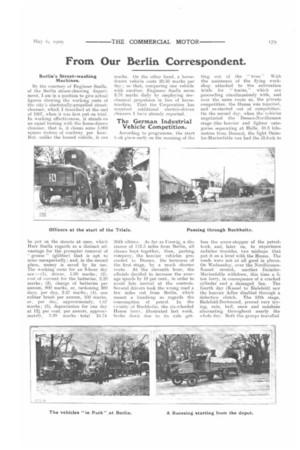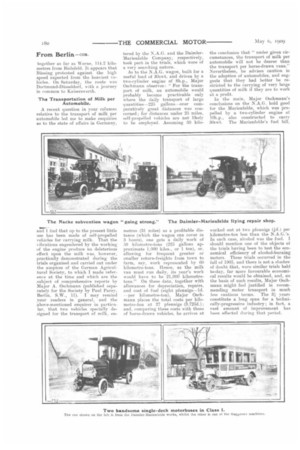From Our Berlin Correspondent.
Page 15

Page 16

If you've noticed an error in this article please click here to report it so we can fix it.
Berlin's Streetswashing Machines, By the courtesy of Engineer Smile, of the Berlin street-cleaning department, I am in a position to give actual figures showing the working costs of the city's electrically-propelled streetcleanser, which I described at the end of 1907, when it was first put on trial. In working effectiveness, it stands on an equal footing with the horse-drawn cleanser, that is, it cleans some 5,000 square metres of roadway per hour. But, unlike the horsed vehicle, it can
be put on the streets at once, svhich Herr Szalla regards as a distinct advantage for the prompter removal of " grease " (glibber) that is apt to arise unexpectedly; and, in the second place, money is saved by its use. The working costs for an 8-hour day are :—(1), driver, 5.00 marks ; (2), cost of current for the batteries, 2.20 marks; (3), charge of batteries per annum, 800 marks, or, reckoning 300 days, per day, 2.67 marks; (4), one rubber brush per annum, 500 marks, or, per day, approximately, 1.67 marks; (5), depreciation for one day at 12i per cent. per annum, approximately, 5,20 marks—total 16.74 miirlcs. On the other band, a horsedrawn vehicle costs '20.50 marks per day ; so that, comparing one vehicle with another, Engineer Szalla saves 3.76 marks daily by employing mechanical propulsion in lieu of horsetraction. That the Corporation has acquired additional electric-driven cleaners I have already reported.
The German Industrial Vehicle Competition.
According to programme, the start tsok place early on the morning of the 26th ultimo. As far as Coswig, a diestance of 112.5 miles from Berlin, all classes kept together, then, parting company, the heavier vehicles proceeded to Dessau, the terminus of the first stage, by a much shorter route. At the eleventh hour, the officials decided to increase the average speeds by 10 per cent., in order to avoid late arrival at the controls. Several drivers took the wrong road a few miles out from Berlin, which meant a handicap as regards the consumption of petrol. In the vicinity of Buckhoitz, the six-wheeled Hansa Lorry, illustrated last week, broke down due to its axle get ting out of the " true." With the assistance of the flying workshop attached to the subvention trials for " trains," which are proceeding simultaneously with, and over the same route as, the private competition, the Hansa was repaired, and re-started out of competition. On the second day, when the vehicles negotiated the Dessau-Nordhausen stage (the heavier and lighter categories separating at Halle, 59.3 kilometres from Dessau), the light Dainiler-Marienfelde van had the ill-luck to lose the screw-stopper of the petroltank, and, later on, to experience radiator troubles, two mishaps that put it on a level with the Hansa. The roads were not at all good in places. On Wednesday, over the NordhausenKassel stretch, another DaimlerMarienfelde withdrew, this time a 5ton lorry, in consequence of a cracked cylinder and a damaged fan. The fourth day (Kassel to Bielefeld) saw the heavier Adler disabled through a defective clutch. The fifth stage, Bielefeld-Dortmund, proved very trying, rain, hail, snow and sunshine alternating throughout nearly the whole day. Both the groups travelled together as far as Werne, 114.2 kilometres from Bielefeld. It appears that Bussing protested against the high speed expected from the heaviest vehicles. On Saturday, the route was Dortmund-Diisseldorf, with a journey in common to Kaiserswerth.
The Transportation of Milk per Automobile.
A recent question in your columns relative to the transport of milk per automobile led me to make enquiries as to the state of affairs in Germany, and I find that up to the present little use has been made of self-propelled vehicles for carrying milk. That the vibrations engendered by the working of the engine produce no deleterious effect upon the milk was, however, practically demonstrated during the trials organised•and carried out under the auspices of the German Agricultural Society, to which I made reference at the time and which are the subject of comprehensive reports by Major A. Oschmann (published separately for the Society by Paul Parey, Berlin, S.W., 1,1). I may remind your readers in general, and the above-mentioned enquirer in particular, that two vehicles specially designed for the transport of milk, en tared by the N.A.G. and the DaimlerMarietifelde Company, respectively, took part in the trials, which were of a very searching nature.
As to the N.A.G. wagon, built for a useful load of 3C/cwt. and driven by a two-cylinder engine of 8h.p., Major Oschmann observes: " For the transport of milk, an automobile would probably become practicable only where the daily transport of large 1uantities-225 gallons--over comparatively great distances was concerned; for distances under 25 miles, self-propelled vehicles are not likely to be employed. Assuming 50 kilo
metres (31 miles) as a profitable distance (which the wagon can cover in 3 hours), one gets a daily work of 50 kilometre-tons (225 gallons approximate 1,000 kilos., or 1 ton), or, allowing for frequent greater or smaller return-freights from town to farm, say, work represented by 60 kilometre-tons. Hence, as the milk van must run daily, its year's work would have to be 21,900 kilometretons." On these data, together with allowances for depreciation, repairs, and cost of fuel (eight pfennigs---1d. —per kilometre-ton), Major Oschmann places the total costs per kilometre-ton at 27 pfennigs (3.725d.); and, comparing these costs with those of horse-drawn vehicles, he arrives at the conclusion that " under given circumstances, the transport of milk per automobile will not be dearer than the transport per horse-drawn vans." Nevertheless, he advises caution in the adoption of automobiles, and suggests that they had better be restricted to the carrying of very large quantities of milk if they are to work at a profit.
.1n the main, Major Oschmann's conclusions on the N.A.G. hold good for the Marienfelde, which was propelled by a two-cylinder engine of 10h.p., also constructed to carry 30cwt. The Marienfelde's fuel bill, worked out at two pfennigs (id.) per kilometre-ton less than the N.A.G.'s. In each case, alcohol was the fuel. I should mention one of the objects of the trials having been to test the economical efficiency of alcohol-burning motors. These trials occurred in the fall of 1905, and there is not a shadow of doubt that, were similar trials held to-day, far more favourable economical results would be obtained, and, on the basis of such results, Major Oschmann might feel justified in recommending motor transport in much less cautious terms. The 31 years constitute a long span for a technically-progressive industry; in fact, a vast amount of improvement has been effected during that period.






















